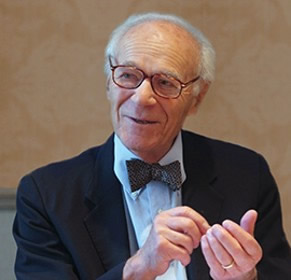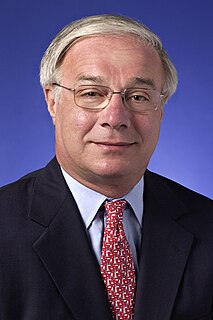Related Research Articles

The Burroughs Corporation was a major American manufacturer of business equipment. The company was founded in 1886 as the American Arithmometer Company. In 1986, it merged with Sperry UNIVAC to form Unisys. The company's history paralleled many of the major developments in computing. At its start, it produced mechanical adding machines, and later moved into programmable ledgers and then computers. It was one of the largest producers of mainframe computers in the world, also producing related equipment including typewriters and printers.
Econometrics is the application of statistical methods to economic data in order to give empirical content to economic relationships. More precisely, it is "the quantitative analysis of actual economic phenomena based on the concurrent development of theory and observation, related by appropriate methods of inference". An introductory economics textbook describes econometrics as allowing economists "to sift through mountains of data to extract simple relationships". Jan Tinbergen is one of the two founding fathers of econometrics. The other, Ragnar Frisch, also coined the term in the sense in which it is used today.

Lawrence Robert Klein was an American economist. For his work in creating computer models to forecast economic trends in the field of econometrics in the Department of Economics at the University of Pennsylvania, he was awarded the Nobel Memorial Prize in Economic Sciences in 1980 specifically "for the creation of econometric models and their application to the analysis of economic fluctuations and economic policies." Due to his efforts, such models have become widespread among economists. Harvard University professor Martin Feldstein told the Wall Street Journal that Klein "was the first to create the statistical models that embodied Keynesian economics," tools still used by the Federal Reserve Bank and other central banks.
Wharton Econometric Forecasting Associates, Inc was an economics forecasting and consulting organization founded by Nobel Prize winner Lawrence Klein.
Otto Eckstein was a German-American economist. He was a key developer and proponent of the theory of core inflation, which proposed that in determining accurate metrics of long run inflation, the transitory price changes of items subject to volatile pricing, such as food and energy, are to be excluded from computation.

A macroeconomic model is an analytical tool designed to describe the operation of the problems of economy of a country or a region. These models are usually designed to examine the comparative statics and dynamics of aggregate quantities such as the total amount of goods and services produced, total income earned, the level of employment of productive resources, and the level of prices.
The BUNCH was the nickname for the group of mainframe computer competitors of IBM in the 1970s. The name is derived from the names of the five companies: Burroughs, UNIVAC, NCR, Control Data Corporation (CDC), and Honeywell. These companies were grouped together because the market share of IBM was much higher than all of its competitors put together.
CANDE is a command line shell and text editor on the MCP operating system which runs on the Unisys Clearpath series of mainframes. Originally implemented on Burroughs large systems, it has a range of features for interacting with the operating system execution environment, focused on executing, editing and compiling programs, and creating, copying, moving, renaming, and deleting files in general.
RATS, an abbreviation of Regression Analysis of Time Series, is a statistical package for time series analysis and econometrics. RATS is developed and sold by Estima, Inc., located in Evanston, IL.
Nariman Behravesh is Chief Economist at the consulting firm IHS Markit and author of Spin-Free Economics: A No-Nonsense, Nonpartisan Guide to Today's Global Economic Debates (McGraw-Hill). Directing the entire economic forecasting process at IHS Markit, he is responsible for developing the economic outlook and risk analysis for the United States, Europe, Japan, China and other emerging markets. He oversees the work of over 400 professionals, located in North America, Europe, Asia, Latin America, the Middle East and Africa who cover economic, financial and political developments in over 200 countries. Behravesh is quoted extensively in the media on such topics as the outlook for the US and global economies, exchange rates, the budget deficit, the trade deficit, globalization, country risk and sovereign debt crises. Dr. Behravesh is a featured speaker at many of the top global conferences each year, including IHS Cambridge Energy Research Associates CERA Week and the World Economic Forum in Davos.

Eric Ghysels is a Belgian-American economist with particular interest in finance and time series econometrics, and in particular the fields of financial econometrics and financial technology. He is the Edward M. Bernstein Distinguished Professor of Economics at the University of North Carolina and a Professor of Finance at the Kenan-Flagler Business School. He is also the Faculty Research Director of the Rethinc.Labs at the Frank Hawkins Kenan Institute of Private Enterprise.
AREMOS is a data management and econometrics software package released by Global Insight. It was most popular in the late 1980s and 1990s, when it was used by leading economists. Developed as a DOS application by Wharton Econometric Forecasting Associates - WEFA now IHS Markit, it has gone through many iterations. Thomsons' Datastream macroeconomic databases which were accessible with AREMOS, were a key selling point.
Donald Baird Marron was an American financier, private equity investor and entrepreneur, notable as the chairman and chief executive officer of brokerage firm Paine Webber from 1980 through the sale of the company in 2000, as well as the founder of private equity firm Lightyear Capital and of Data Resources Inc. He was the father of the economist Donald B. Marron Jr.

David Wyss is an American economist. As New York-based Standard & Poor's chief economist, Wyss was responsible for S & P's economic forecasts and publications. He also coauthored the monthly Equity Insight and the weekly Financial Notes. He was on the board of the National Association for Business Economics, Washington, D.C.
SHAZAM is a comprehensive econometrics and statistics package for estimating, testing, simulating and forecasting many types of econometrics and statistical models. SHAZAM was originally created in 1977 by Kenneth White.
Following the development of Keynesian economics, applied economics began developing forecasting models based on economic data including national income and product accounting data. In contrast with typical textbook models, these large-scale macroeconometric models used large amounts of data and based forecasts on past correlations instead of theoretical relations. These models estimated the relations between different macroeconomic variables using regression analysis on time series data. These models grew to include hundreds or thousands of equations describing the evolution of hundreds or thousands of prices and quantities over time, making computers essential for their solution. While the choice of which variables to include in each equation was partly guided by economic theory, variable inclusion was mostly determined on purely empirical grounds. Large-scale macroeconometric model consists of systems of dynamic equations of the economy with the estimation of parameters using time-series data on a quarterly to yearly basis.
Carl Weinberg is an American economist. He is the founder, Chief Economist and managing director of High Frequency Economics, an economic research firm located in Valhalla, NY.

Michael Patrick Keane is an American/Australian economist who is currently professor of economics and Australian Research Council laureate fellow at the University of New South Wales. From 2012 to 2017 he was the Nuffield Professor of Economics at the University of Oxford and a professorial fellow of Nuffield College. He is considered one of the world's leading experts in the fields of Choice Modelling, structural modelling, simulation estimation, and panel data econometrics.
Zvi Eckstein is a full professor, dean, Arison School of Business and Tiomkin School of Economics at The Interdisciplinary Center Herzliya - IDC. Emeritus Professor at the Eitan Berglas School of Economics, Tel Aviv University. Head, the Aaron Economic Policy Institute, IDC, Herzliya. University of Pennsylvania, the Wharton School, Finance Department, Judith C. and William G. Bollinger Visiting Professor Served as deputy governor, Bank of Israel (2006-2011). The Walras-Bowely Lecturer, the Econometric Society, North America Summer Meetings, Pittsburgh, US, June 19, 2008. Fellow of the Econometric Society.
Edwin Kuh was an American economist. He was a faculty member at the MIT Sloan School of Management for over 30 years, and was widely known for his work with econometric models to forecast production, savings, investment, business cycle, unemployment, and related functions. John Kenneth Galbraith called him "one of the most innovative economists of his generation."
References
- ↑ "Johnson Conversation with Otto Eckstein on May 04, 1964 (WH6405.02)—Presidential Recordings Program—Miller Center". Archived from the original on 2013-12-13. Retrieved 2013-12-06.
- ↑ https://www.nber.org/chapters/c10018.pdf [ bare URL PDF ]
- ↑ Arenson, Karen W. (23 March 1984). "Otto Ecktein, Educator Who Led in Economic Forecasting". The New York Times.
- ↑ "Richard Hokenson Home Page". Archived from the original on 2010-07-26. Retrieved 2013-12-07.
- ↑ "Burroughs B6700 - retroComputingTasmania".
- ↑ Burroughs large systems
- ↑ Kraemer, Kenneth L. (24 September 1987). Datawars: The Politics of Modeling in Federal Policymaking. ISBN 9780231519168.
- ↑ Kenneth Kraemer, Datawars: The Politics of Modeling in Federal Policymaking. https://www.amazon.com/Datawars-Politics-Modeling-Federal-Policymaking/dp/0231062044
- ↑ Arenson, Karen W. (23 March 1984). "Otto Ecktein, Educator Who Led in Economic Forecasting". The New York Times.
- ↑ "McGraw Hill Inc. Plans to Buy Company Run by Otto Eckstein; Data Resources Stock Jumps | News | The Harvard Crimson".
- ↑ Sloane, Leonard (22 June 1981). "Business People; SHIFT AT DATA RESOURCES". The New York Times.
- ↑ Wayne, Leslie (16 December 1984). "Dismantling the Innovative D.r.i." The New York Times.
- ↑ Gilpin, Kenneth N. (2 April 1987). "2 Forecasting Firms to Merge". The New York Times.
- ↑ "DRI-WEFA's Macroeconomic Models - ICCF".
- ↑ Wharton Econometric Forecasting Associates
- ↑ "To make better decisions, you need to see the big picture".